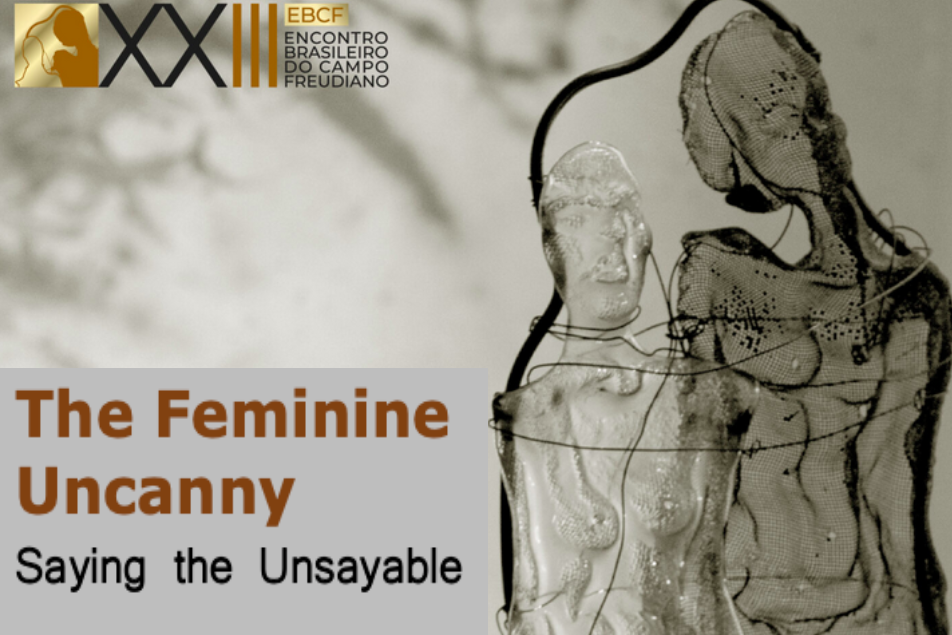translated by Marcela Antelo
reviewed by Nicholas Csergo
and Gary Marshall
23rd Brazilian Encounter of the Freudian Field / 20th to 22nd November 2020 – Hotel Fiesta – Salvador – Bahia
Guest Speaker: Christiane Alberti (ECF – Paris) encontrobrasileiro2020.com.br
Argument
The feminine is one of the names for our contemporary discontent. This isn’t the first time it elicits our attention and it certainly won’t be the last. The stuff of our gathering is inspired by a research programme that stirs and rouses our community and its many littorals. We always start from an unknown and, on this occasion, we’ll also have to factor-in an unknowable. This time we were interested in stretching the boundary of the sayable about the feminine, beyond our everyday ‘disance’.
In doing so, we wanted to cross the feminine with that quality of feeling, embodied in what Freud called Das Unheimliche, an experience that’s been unpacked for one hundred years. The link has already been made by several authors in the littorals of our field. We would like to say it in Other way, to get to this affaire – as per Joyce’s Witz – “where the hand of man never set foot”[1].
The phenomenon of the uncanny in Freud seems to date from his approach to his female hysterical patients and their symptoms, who exhibited fantastical bodies, remarkable for their strange effects on subjectivity. The feminine appears linked to the impossibility of symbolically representing the subjects’ experience of their body –so intimate and strange it cannot be shared.
More specifically, women appear in Freud’s 1919 The Uncanny, when he argues on the factor of repetition as a source of the “uncanny feeling”[2], which he considers will not be easily recognisable to everyone.
The context is Freud’s ‘random’ walk, “As I was walking, one hot summer afternoon, through the deserted streets of a provincial town in Italy which was unknown to me”. He comes across “a quarter of whose character I could not long remain in doubt.” We cannot but quote it, to distill the essence of our inquiry. “Nothing but painted women were to be seen at the windows of the small houses, and I hastened to leave the narrow street at the next turning”. Freud fails, unable to flee, going around in circles, ultimately condemned to what he terms an involuntary return to the same place, the colorful, feminine windows. Helplessness and uncanniness, the feelings of the norm/male. Fumbling for the light switch in a darkened room, like the stone in mid-path intimately familiar to the Freudian Field in Brazil, he trips over a piece of furniture.
What is Freud fleeing? The depths of a throat, a Medusa, a devouring, female praying mantis? The easy way out is an oedipal, phallic reading, invoking the second condition and secretly familiar proximity Dirne-Mother, to Dirnenhaftbarkeit, the “status of whore” and to substantiate a rejection of femininity; a Freud who unhesitatingly leaves. We’re already familiar with the Trem das onze[3] syndrome.
What fire do these open windows and Boquitas Pintadas[4] signal, this exhibitionist quarter[5] what does it provoke? Is it enough to point out the knot of desire and defence in the Other scene? Or is there something in these women that won’t submit to castration?[6] What opaque thing draws him back? Why does he come back again and again, making of this return an example of an uncanny experience?
The walk in the “space between two worlds […] indicates the passage from the closed world to the infinite universe”[7]. In this walk, Freud illuminates the experience of what doesn’t exist, what ek-sists. Feminine jouissance and the uncanny experience occur within the body and “parlêtres in general have trouble dealing with the feminine body”[8]. Generally, regardless of their chosen door to urinary segregation, jouissance as such, theorised starting from feminine jouissance “is [gender] neutral”, was Miquel Bassols’ recent Witz.
As we go, we will establish whether the uncanny feminine may lead us to an entire field that psychoanalysis approaches – in the clinical, in epistemics and in relation to other fields.
So let’s grab our lanterns, candles, and why not our mobile phones, to plunge, not so randomly, bearing maps, breadcrumbs, roadside graffiti, into the overly proximate, uncanny feminine. The challenge is to say what we find there.
Marcela Antelo – Iordan Gurgel
Salvador, Bahia, January 2020
——————————
[1] Joyce, James, Finnegans Wake, Penguin UK, 2000. p.203.
[2] Freud, Sigmund, “The ‘Uncanny”, The Standard Edition of the Complete Psychological Works of Sigmund Freud, Volume XVII (1917-1919), 217-256.
[3] The 1964 samba song Trem Das Onze (The 11pm Train) song by Adoniran Barbosa is the lament of a man who has to leave his date to catch the last train and go and look after his mother.
[4] TN: Little Painted Mouths, the original title of Manuel Puig’s 1969 novel, translated into English as Heartbreak Tango.
[5] Lacan, Jacques, [1964] The Seminar of Jacques Lacan. Book XI. The Four Fundamental Concepts of Psychoanalysis, ed. Jacques-Alain Miller, New York: W. W. Norton and Company Inc., 1998. p. 75. «The world is all-seeing but it is not exhibitionist – it does not provoke our gaze. When it begins to provoque it, the feeling of strangeness begins too.».
[6] Miller, Jacques-Alain, “L’être et l’Un” [Being and the One]. Lacanian Orientation III, 13, Course n. 5. Lesson 2/3/2011. «[…] ça dit qu’il y a quelque chose chez les femmes qui n’est pas pris dans la castration. Et c’est pourquoi Lacan pouvait dire, écrire, d’une façon qui a pu surprendre, que c’est de ce côté -là que gît le mystère, ce qui fait mystère de la jouissance féminine ». p. 10
[7] Vieira, Marcus André, “A inquietante estranheza do fenômeno à estrutura” [The Uncanny, from the phenomenon to the structure]. Published in Latusa, n. 4, Rio de Janeiro, EBP-Rio e Contra Capa, 1999.
[8] Brousse, Marie-Hélène, Mulheres e discursos [Women and Discourses]. Rio de Janeiro: Contra Capa, 2019. p. 37.








